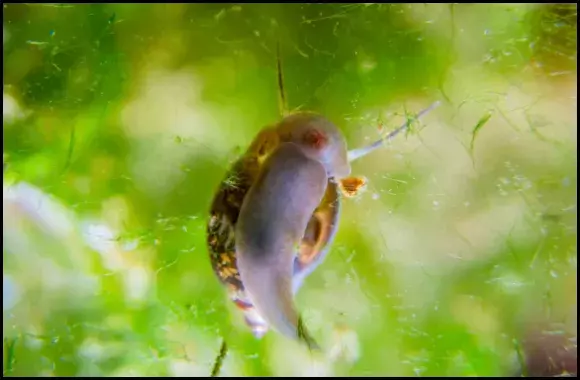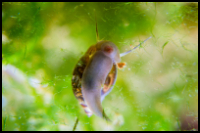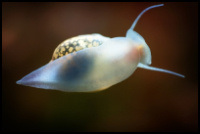



Quick Care Details (Table)
| Livestock Characteristics | Value |
|---|---|
| Care Level | Easy |
| Temperament | Peaceful |
| Diet | Omnivore |
| Maximum Size | 1 Inch |
| Minimum Tank Size | 5 Gallons |
| Plant Safe | Yes |
| Temperature Range | 70°F to 78°F (21°C to 25.5°C) |
| PH Range | 7.0 to 8.0 pH |
| KH Range | 6 - 12 dGH |
| GH Range | 3 - 8 dKH |
Species Specific Categories
Helpful Video
Care Details
- Aquascape: Bladder snails prefer aquariums with plenty of hiding spots and surfaces to graze on. Adding live plants, driftwood, and rocks can create a suitable habitat for them.
- Substrate: They do well with a variety of substrates, but fine sand or smooth gravel is preferred to prevent damage to their delicate bodies.
- Disease Prevention: Maintain good water quality through regular water changes and proper filtration to prevent the buildup of harmful substances. Quarantine new additions to the aquarium to prevent the introduction of diseases.
- Filtration: Adequate filtration is essential to keep the water clean and oxygenated. A sponge or foam filter works well for a bladder snail aquarium, providing gentle water flow without sucking them into the filter.
- Lighting: Moderate to low lighting is sufficient for bladder snails, as they are primarily active at night and do not have specific lighting requirements.
- Water Flow: Gentle water flow is ideal for bladder snails, as strong currents can stress them and inhibit their ability to graze on surfaces.
- Hardiness: Bladder snails are generally hardy and can tolerate a wide range of water conditions, but sudden fluctuations in temperature or water parameters should be avoided.
- Acclimation: When introducing bladder snails to a new aquarium, acclimate them slowly by floating their container in the tank and gradually adding small amounts of tank water over a period of time.
- Expected Lifespan: In captivity, bladder snails typically live for about 1-2 years, although this can vary depending on factors such as water quality and availability of food.
- Special Requirements: Bladder snails have few special requirements but appreciate a stable environment with consistent water parameters and minimal disturbances. Avoid introducing aggressive tank mates that may harm or stress them.
Temperament and Behavior
- Behavior: Bladder snails are peaceful and non-aggressive freshwater snails. They spend much of their time grazing on surfaces and scavenging for food.
- Breeding: Bladder snails are prolific breeders and reproduce quickly under favorable conditions. They are hermaphroditic, meaning each individual possesses both male and female reproductive organs, facilitating rapid reproduction.
- Aggression: Bladder snails are not aggressive towards other tank inhabitants and generally coexist peacefully with fish and other aquarium species.
- Tankmates Compatibility: Bladder snails are compatible with most freshwater aquarium inhabitants, including small fish, shrimp, and other snail species. However, avoid introducing aggressive or predatory species that may harm or eat them.
- Activity Level: Bladder snails are primarily active at night, although they may also be active during the day, especially when searching for food.
- Schooling or Shoaling Behavior: Bladder snails do not exhibit schooling or shoaling behavior. They are solitary creatures and prefer to forage and graze individually.
- Plant Compatibility: Bladder snails are generally compatible with live aquarium plants. While they may nibble on plant leaves occasionally, they rarely cause significant damage and can help control algae growth. However, in heavily planted tanks, they may reproduce more rapidly due to the abundance of hiding spots and food sources.
Diet and Nutrition
- Dry Foods: Bladder snails will consume various dry foods such as sinking pellets, flakes, and algae wafers. These can be an essential part of their diet, providing essential nutrients.
- Frozen Foods: While bladder snails primarily consume algae and detritus, they may occasionally consume small particles of frozen foods like bloodworms or brine shrimp if they sink to the bottom of the aquarium.
- Live Foods: Bladder snails will readily consume live foods such as microorganisms, small insects, and other invertebrates that they encounter in the aquarium.
- Vegetables: Bladder snails can also consume vegetables like blanched zucchini, cucumber, and spinach. These can be attached to a weighted clip and placed in the aquarium for them to graze on.
- Algae: Algae make up a significant portion of bladder snails' diet. They will actively graze on algae growing on surfaces such as glass, rocks, and plants, helping to control algae growth in the aquarium.
- Feeding Schedule: Bladder snails are opportunistic feeders and will graze continuously throughout the day and night. While they can survive on algae and detritus alone, it's beneficial to supplement their diet with occasional feedings of commercial sinking pellets or vegetables.
- Supplemental Foods: In addition to algae and detritus, bladder snails can benefit from supplemental foods such as sinking pellets, algae wafers, blanched vegetables, and occasional offerings of live or frozen foods. These can provide essential nutrients and help ensure their overall health and vitality.
Tank Parameters
- Tank Size: Bladder snails can thrive in tanks of various sizes, ranging from small nano tanks to larger aquarium setups. A minimum tank size of 10 gallons is recommended to provide adequate space and water volume.
- Tank Length and Measurements: While bladder snails can adapt to various tank dimensions, longer tanks with ample surface area are preferred, as they provide more grazing and exploration space for the snails.
- Water Temperature: Bladder snails are adaptable to a wide range of temperatures commonly found in freshwater aquariums. They thrive in temperatures between 70°F to 78°F (21°C to 25.5°C).
- pH (Acidity/Alkalinity): Bladder snails are tolerant of a wide pH range, but they prefer slightly alkaline to neutral conditions. A pH range between 7.0 to 8.0 is suitable for their well-being.
- KH (Carbonate Hardness): Bladder snails can tolerate a range of carbonate hardness levels (KH), but stable levels between 3 to 8 dKH are generally recommended for optimal health.
- GH (General Hardness): Bladder snails are adaptable to various levels of general hardness (GH), but moderately hard water with a range between 6 to 12 dGH is suitable for their overall well-being.
- Hardiness: Bladder snails are considered hardy and can tolerate a wide range of water parameters as long as they remain relatively stable. Sudden fluctuations in water parameters can stress them and impact their health.
- Nitrate (NO3) Levels: Bladder snails are relatively tolerant of low to moderate nitrate levels in the aquarium. However, it's essential to monitor and maintain nitrate levels below 40 ppm (parts per million) to ensure optimal water quality and overall aquarium health. Regular water changes and proper filtration help control nitrate levels in the tank.
History, Popularity, History and Species Variety Details
The History, Popularity, and Natural Habitat
History
The bladder snail (Physella acuta) is a freshwater snail species that has been a part of the aquarium hobby for many years. Its exact origin is not precisely documented, but it is believed to be native to North America. Over time, bladder snails have become widespread in freshwater habitats worldwide due to their ability to adapt to various environmental conditions.
Popularity
Bladder snails are popular among aquarium enthusiasts for several reasons. They are known for their ability to consume algae and detritus, helping to keep aquariums clean and balanced. Additionally, bladder snails are easy to care for and reproduce readily, making them suitable for beginner aquarists and experienced hobbyists alike. Their small size and peaceful nature also make them compatible with a wide range of tank mates.
Natural Habitat
In their natural habitat, bladder snails can be found in various freshwater environments, including ponds, lakes, rivers, and streams. They are adaptable creatures, capable of thriving in both stagnant and flowing water conditions. Bladder snails typically inhabit areas with plenty of vegetation and organic debris, where they graze on algae and detritus. They play a vital role in freshwater ecosystems by helping to break down organic matter and recycle nutrients.
Back to topSimilar and Variations of the Species
- Malaysian Trumpet Snail (Melanoides tuberculata): These snails are known for their elongated, cone-shaped shells and are often found burrowing in the substrate of aquariums. They help aerate and stir the substrate, preventing anaerobic pockets from forming.
- Ramshorn Snail (Planorbidae family): Ramshorn snails have flat, disk-shaped shells with a spiral pattern. They come in various colors, including red, brown, and black, and are known for their rapid reproduction in aquariums.
- Pond Snails (Lymnaeidae family): Pond snails have elongated, conical shells and are commonly found in freshwater ponds, lakes, and streams. They are adaptable and can thrive in a range of water conditions.
- Assassin Snails (Clea helena): These snails are predators that feed on other snails, making them useful for controlling populations of pest snails in aquariums. They have distinctive yellow and brown striped shells.
- Nerite Snails (Neritina family): Nerite snails have small, round shells with intricate patterns and come in various colors and patterns. They are known for their voracious appetite for algae and are popular in aquariums for their algae-eating abilities.
Compatible Species to Keep With Your Snail
- Small Freshwater Fish: Species like neon tetras, guppies, platies, mollies, and Corydoras catfish are peaceful and suitable tank mates for bladder snails.
- Shrimp: Dwarf shrimp species such as cherry shrimp, Amano shrimp, and ghost shrimp are compatible with bladder snails. They help clean up leftover food and algae in the aquarium.
- Other Peaceful Snails: Snail species like mystery snails (Pomacea diffusa), nerite snails (Neritina spp.), and ramshorn snails (Planorbidae family) are generally peaceful and can coexist with bladder snails.
- Bottom Dwellers: Bottom-dwelling species like otocinclus catfish, small plecos (such as bristlenose plecos), and kuhli loaches are compatible with bladder snails and help keep the tank clean.
- Small Invertebrates: In addition to shrimp, other small invertebrates like dwarf crayfish and freshwater clams can also be compatible tank mates for bladder snails.
Frequently Asked Questions
How long do bladder snails typically live?
In captivity, bladder snails typically have a lifespan of around 1-2 years, although this can vary depending on factors such as water quality and availability of food.
Can bladder snails carry diseases harmful to my other aquarium inhabitants?
Bladder snails are relatively hardy and not particularly susceptible to diseases. However, they can serve as intermediate hosts for certain parasites that affect fish, so it's essential to monitor their population and maintain good aquarium hygiene.
How do I control bladder snail populations in my aquarium?
To control bladder snail populations, avoid overfeeding your fish, as excess food can lead to rapid snail reproduction. You can also manually remove excess snails during water changes or introduce natural predators like assassin snails.
Will bladder snails eat my aquarium plants?
While bladder snails may nibble on soft or decaying plant matter, they generally do not cause significant damage to healthy aquarium plants. They primarily graze on algae and detritus.
How fast do bladder snails reproduce?
Bladder snails are prolific breeders and can reproduce rapidly under favorable conditions. They are hermaphroditic, meaning each individual possesses both male and female reproductive organs, facilitating quick reproduction.

